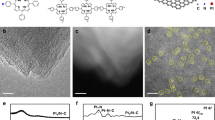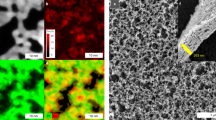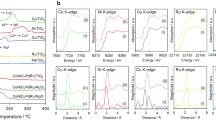Abstract
The water–gas shift (WGS) reaction is an industrially important source of pure hydrogen (H2) at the expense of carbon monoxide and water1,2. This reaction is of interest for fuel-cell applications, but requires WGS catalysts that are durable and highly active at low temperatures3. Here we demonstrate that the structure (Pt1–Ptn)/α-MoC, where isolated platinum atoms (Pt1) and subnanometre platinum clusters (Ptn) are stabilized on α-molybdenum carbide (α-MoC), catalyses the WGS reaction even at 313 kelvin, with a hydrogen-production pathway involving direct carbon monoxide dissociation identified. We find that it is critical to crowd the α-MoC surface with Pt1 and Ptn species, which prevents oxidation of the support that would cause catalyst deactivation, as seen with gold/α-MoC (ref. 4), and gives our system high stability and a high metal-normalized turnover number of 4,300,000 moles of hydrogen per mole of platinum. We anticipate that the strategy demonstrated here will be pivotal for the design of highly active and stable catalysts for effective activation of important molecules such as water and carbon monoxide for energy production.
This is a preview of subscription content, access via your institution
Access options
Access Nature and 54 other Nature Portfolio journals
Get Nature+, our best-value online-access subscription
$29.99 / 30 days
cancel any time
Subscribe to this journal
Receive 51 print issues and online access
$199.00 per year
only $3.90 per issue
Buy this article
- Purchase on Springer Link
- Instant access to full article PDF
Prices may be subject to local taxes which are calculated during checkout




Similar content being viewed by others
Data availability
The main data supporting the findings of this study are available within the paper and its Supplementary Information. Additional data are available from the corresponding authors upon reasonable request.
References
Zhai, Y. et al. Alkali-stabilized Pt-OHx species catalyze low-temperature water–gas shift reactions. Science 329, 1633–1636 (2010).
Rodriguez, J. A. et al. Activity of CeOx and TiOx nanoparticles grown on Au(111) in the water–gas shift reaction. Science 318, 1757–1760 (2007).
Ladebeck, J. R. & Wagner, J. P. in Handbook of Fuel Cells (eds Vielstich, W., Lamm, A. & Gasteiger, H. A.) Ch. 16, 197 (Wiley, 2003).
Yao, S. et al. Atomic-layered Au clusters on α-MoC as catalysts for the low-temperature water–gas shift reaction. Science 357, 389–393 (2017).
Yang, M. et al. A common single-site Pt(ii)–O(OH)x– species stabilized by sodium on “active” and “inert” supports catalyzes the water–gas shift reaction. J. Am. Chem. Soc. 137, 3470–3473 (2015).
Fu, Q., Saltsburg, H. & Flytzani-Stephanopoulos, M. Active nonmetallic Au and Pt species on ceria-based water–gas shift catalysts. Science 301, 935–938 (2003).
Yang, M. et al. Catalytically active Au–O(OH)x– species stabilized by alkali ions on zeolites and mesoporous oxides. Science 346, 1498–1501 (2014).
Zugic, B. et al. Probing the low-temperature water–gas shift activity of alkali-promoted platinum catalysts stabilized on carbon supports. J. Am. Chem. Soc. 136, 3238–3245 (2014).
Ding, K. et al. Identification of active sites in CO oxidation and water–gas shift over supported Pt catalysts. Science 350, 189–192 (2015).
Schweitzer, N. M. et al. High activity carbide supported catalysts for water gas shift. J. Am. Chem. Soc. 133, 2378–2381 (2011).
Li, Z. et al. Reactive metal–support interactions at moderate temperature in two-dimensional niobium-carbide-supported platinum catalysts. Nat. Catal. 1, 349–355 (2018).
Hunt, S. T. et al. Self-assembly of noble metal monolayers on transition metal carbide nanoparticle catalysts. Science 352, 974–978 (2016).
Lu, J., Aydin, C., Browning, N. D. & Gates, B. C. Hydrogen activation and metal hydride formation trigger cluster formation from supported iridium complexes. J. Am. Chem. Soc. 134, 5022–5025 (2012).
Fierro-Gonzalez, J. C. & Gates, B. C. Mononuclear AuIII and AuI complexes bonded to zeolite NaY: catalysts for CO oxidation at 298 K. J. Phys. Chem. B 108, 16999–17002 (2004).
Lu, J., Aydin, C., Browning, N. D. & Gates, B. C. Imaging isolated gold atom catalytic sites in zeolite NaY. Angew. Chem. Int. Ed. 51, 5842–5846 (2012).
Miller, J. T. et al. The effect of gold particle size on Au–Au bond length and reactivity toward oxygen in supported catalysts. J. Catal. 240, 222–234 (2006).
Dong, J. et al. Carbide-supported Au catalysts for water–gas shift reactions: a new territory for the strong metal–support interaction effect. J. Am. Chem. Soc. 140, 13808–13816 (2018).
Sabnis, K. D. et al. Water–gas shift catalysis over transition metals supported on molybdenum carbide. J. Catal. 331, 162–171 (2015).
Lin, L. et al. Low-temperature hydrogen production from water and methanol using Pt/α-MoC catalysts. Nature 544, 80–83 (2017).
Lin, J. et al. Remarkable performance of Ir1/FeOx single-atom catalyst in water gas shift reaction. J. Am. Chem. Soc. 135, 15314–15317 (2013).
Fu, Q., Deng, W., Saltsburg, H. & Flytzani-Stephanopoulos, M. Activity and stability of low-content gold-cerium oxide catalysts for the water–gas shift reaction. Appl. Catal. B 56, 57–68 (2005).
Murugappan, K. et al. Operando NAP-XPS unveils differences in MoO3 and Mo2C during hydrodeoxygenation. Nat. Catal. 1, 960–967 (2018).
Porosoff, M. D., Yang, X., Boscoboinik, J. A. & Chen, J. G. Molybdenum carbide as alternative catalysts to precious metals for highly selective reduction of CO2 to CO. Angew. Chem. Int. Ed. 53, 6705–6709 (2014).
Prosvirin, I. P., Bukhtiyarov, A. V., Bluhm, H. & Bukhtiyarov, V. I. Application of near ambient pressure gas-phase X-ray photoelectron spectroscopy to the investigation of catalytic properties of copper in methanol oxidation. Appl. Surf. Sci. 363, 303–309 (2016).
Mudiyanselage, K. et al. Importance of the metal-oxide interface in catalysis: in situ studies of the water–gas shift reaction by ambient-pressure X-ray photoelectron spectroscopy. Angew. Chem. Int. Ed. 52, 5101–5105 (2013).
Lin, L. et al. A highly CO-tolerant atomically dispersed Pt catalyst for chemoselective hydrogenation. Nat. Nanotechnol. 14, 354–361 (2019).
Namiki, T., Yamashita, S., Tominaga, H. & Nagai, M. Dissociation of CO and H2O during water–gas shift reaction on carburized Mo/Al2O3 catalyst. Appl. Catal. A 398, 155–160 (2011).
Kalamaras, C. M., Americanou, S. & Efstathiou, A. M. “Redox” vs “associative formate with –OH group regeneration” WGS reaction mechanism on Pt/CeO2: effect of platinum particle size. J. Catal. 279, 287–300 (2011).
Deng, W., Carpenter, C., Yi, N. & Flytzani-Stephanopoulos, M. Comparison of the activity of Au/CeO2 and Au/Fe2O3 catalysts for the CO oxidation and the water–gas shift reactions. Top. Catal. 44, 199–208 (2007).
Yang, M., Allard, L. F. & Flytzani-Stephanopoulos, M. Atomically dispersed Au– (OH)x species bound on titania catalyze the low-temperature water–gas shift reaction. J. Am. Chem. Soc. 135, 3768–3771 (2013).
de la Peña, F. et al. hyperspy/hyperspy: HyperSpy v1.5.2. https://doi.org/10.5281/zenodo.3396791 (2019).
Herzing, A. A. et al. Identification of active gold nanoclusters on iron oxide supports for CO oxidation. Science 321, 1331–1335 (2008).
Artiglia, L. et al. Introducing time resolution to detect Ce3+ catalytically active sites at the Pt/CeO2 interface through ambient pressure X-ray photoelectron spectroscopy. J. Phys. Chem. Lett. 8, 102–108 (2017).
Orlando, F. et al. The environmental photochemistry of oxide surfaces and the nature of frozen salt solutions: a new in situ XPS approach. Top. Catal. 59, 591–604 (2016).
Acknowledgements
This work received financial support from the Natural Science Foundation of China (21725301, 21932002, 21821004, 91645115, 51622211, 21577013, 21707015, 21872014, 21902018), the National Key R&D Program of China (2017YFB0602200, 2017YFA0700103, 2018YFA0305800), and the Beijing Outstanding Young Scientist Program (BJJWZYJH01201914430039). The X-ray absorption spectroscopy and X-ray diffraction experiments were conducted at the Shanghai Synchrotron Radiation Facility and the Beijing Synchrotron Radiation Facility. The Pt L3 edge X-ray absorption spectroscopy for 0.02 wt% Pt/α-MoC was conducted at beamline10-BM, MRCAT operations, Advanced Photon Source under contract number DEAC02-06CH11357. The AP-XPS experiments were conducted in Swiss Light Source synchrotron. D.M. acknowledges support from the Tencent Foundation through the XPLORER PRIZE.
Author information
Authors and Affiliations
Contributions
D.M. conceived the project. D.M., W.Z., M.F.-S. and C.S. supervised the study. Xiao Zhang and M.Z. performed most of the reactions. M.X., A.L., J.S. and W.Z. performed the electron microscopy study. M.Z., Xiaochen Zhang, L.A. and J.A.v.B. did the NAP-XPS experiments. M.Z., J.Y. and B.C. did the TKA experiments. Y.D., M.P., C.Y., W.W., X.G., Z.J., S.Y. and A.J.K. performed the X-ray structure characterization (XAS and XRD) and analysis. S.Y. contributed to the calculation of the cost targets profile of the Au- or Pt-based WGS catalysts. M.Z., M.B. and J.X. did the XPS experiments. R.G., X.W. and Y.-W.L. did the DFT calculations. S.C. did the low-temperature reaction evaluation experiments. Xiao Zhang, M.Z., Y.D., W.Z., M.F.-S. and D.M. wrote the paper. All the authors discussed and revised the paper.
Corresponding authors
Ethics declarations
Competing interests
The authors declare no competing interests.
Additional information
Peer review information Nature thanks Matteo Cargnello and the other, anonymous, reviewer(s) for their contribution to the peer review of this work.
Publisher’s note Springer Nature remains neutral with regard to jurisdictional claims in published maps and institutional affiliations.
Supplementary information
Supplementary Information
This file contains Supplementary Figures S1-S19 and Supplementary Tables S1 and S2.
Rights and permissions
About this article
Cite this article
Zhang, X., Zhang, M., Deng, Y. et al. A stable low-temperature H2-production catalyst by crowding Pt on α-MoC. Nature 589, 396–401 (2021). https://doi.org/10.1038/s41586-020-03130-6
Received:
Accepted:
Published:
Issue Date:
DOI: https://doi.org/10.1038/s41586-020-03130-6
This article is cited by
-
Light alters reaction pathways
Nature Energy (2024)
-
Photochemical tuning of dynamic defects for high-performance atomically dispersed catalysts
Nature Materials (2024)
-
Reverse water gas-shift reaction product driven dynamic activation of molybdenum nitride catalyst surface
Nature Communications (2024)
-
Direct conversion of CO and H2O to hydrocarbons at atmospheric pressure using a TiO2−x/Ni photothermal catalyst
Nature Energy (2024)
-
Photothermal catalysts for efficient and clean fuel production at atmospheric pressure
Science China Chemistry (2024)
Comments
By submitting a comment you agree to abide by our Terms and Community Guidelines. If you find something abusive or that does not comply with our terms or guidelines please flag it as inappropriate.



